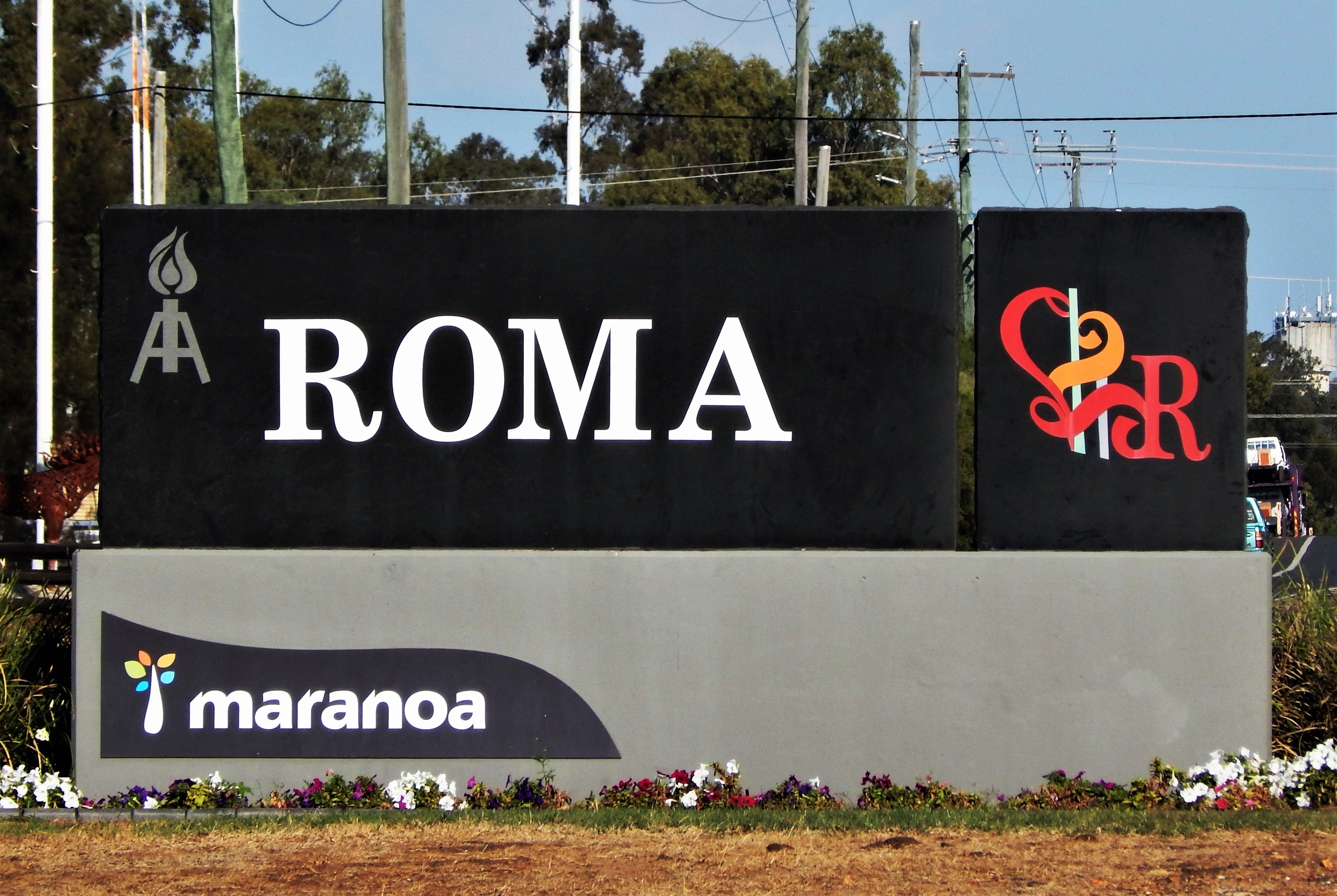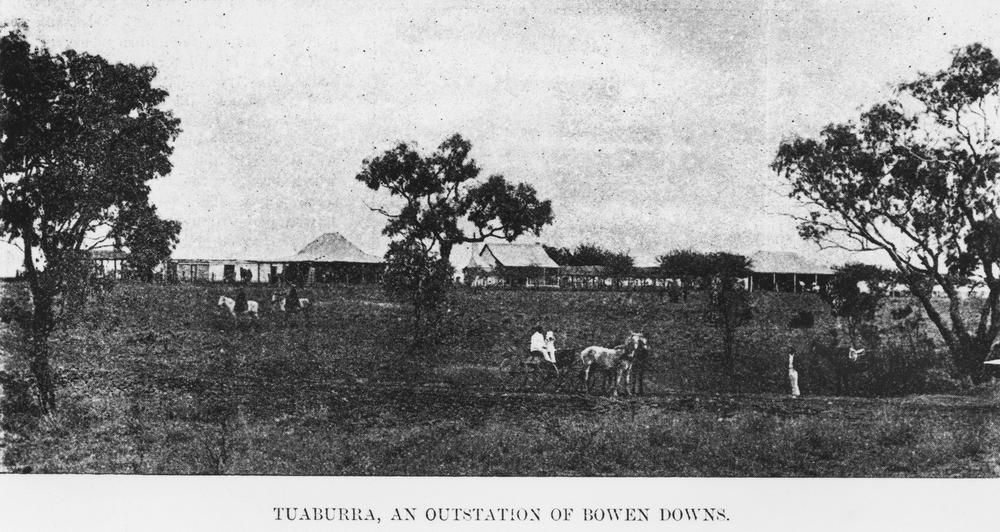|
Roma Courthouse
Roma Courthouse is a heritage-listed courthouse at 141 McDowall Street, Roma, Maranoa Region, Queensland, Australia. Constructed in 1901, the courthouse is a rendered masonry building, which is still in use today. Predominately influenced by the Federation free style, it is considered a stunning example of Federation colonial architecture at its best. It is also known as Roma Court House and Roma Police Buildings. It was added to the Queensland Heritage Register on 7 August 1998. History The Roma Courthouse is a rendered masonry building located on a triangular block facing McDowall Street. It was constructed between 1900 and 1901 and was designed by architect John Smith Murdoch, the Second Assistant Architect of the Queensland Works Department. The Police Buildings were completed in 1919 as the Roma police station, barracks, offices and cell block, servicing the Roma district. The Roma Police Buildings are simple single-storeyed timber buildings adjacent to the Roma Court ... [...More Info...] [...Related Items...] OR: [Wikipedia] [Google] [Baidu] |
Roma, Queensland
Roma is a rural town and locality in the Maranoa Region, Queensland, Australia. It is the administrative centre of the Maranoa Region. The town was incorporated in 1867 and is named after Lady Diamantina Bowen (née di Roma), the wife of Sir George Bowen, the Governor of Queensland at the time. In the , the locality of Roma had a population of 6,848 people. Geography Roma is in the Maranoa district of South West Queensland, Australia, situated * by rail and road WNW of Brisbane * 355 km (221 mi) W of Toowoomba, * 269 km (167 mi) W of Dalby * 141 km (87.6 mi) W of Miles * 87 km (54 mi) E of Mitchell * 176.6 km (109.7 mi) E of Morven * 266 km (165 mi) E of Charleville It is situated at the junction of the Warrego and Carnarvon highways. It is the centre of a rich pastoral and wheat-growing district. It is also a major town on the Western Railway Line from Toowoomba and Brisbane. History Prior the European settlement the Aboriginal peoples of the Mandandanji Nation o ... [...More Info...] [...Related Items...] OR: [Wikipedia] [Google] [Baidu] |
Bowen Downs Station
Bowen Downs Station is a pastoral lease that has operated both as a cattle station and a sheep station. It is located about east of Muttaburra and north west of Aramac in the outback of Queensland. It is watered by the Thomson River and tributaries Reedy Creek and Cornish Creek that all run through the property. History The traditional owners of the area are the Iningai peoples. Iningai (also known as Yiningay, Muttaburra, Tateburra, Yinangay, Yinangi) is an Australian Aboriginal language spoken by the Iningai people. The Iningai language region includes the landscape within the local government boundaries of the Longreach Region and Barcaldine Region, particularly the towns of Longreach, Barcaldine, Muttaburra and Aramac as well as the properties of Bowen Downs and catchments of Cornish Creek and Alice River. The first Europeans to visit the area were the explorers William Landsborough and Nathaniel Buchanan who passed through in 1860. Landsborough named the area Bo ... [...More Info...] [...Related Items...] OR: [Wikipedia] [Google] [Baidu] |
Captain Starlight
Frank Pearson (1837–22 December 1899) was an Australian bushranger, operating under the pseudonym ''Captain Starlight.'' Pearson claimed he was the inspiration for a fictional figure of the same pseudonym: the character Captain Starlight in Rolf Boldrewood's novel, of 1882–1883, ''Robbery Under Arms''. Boldrewood, who presumably had some insight into the matter, denied the claim and stated that the character was a composite of several bushrangers of the era, including Henry Readford, and primarily Thomas Smith, alias ''Captain Midnight''. The cattle thief Readford did not use a pseudonym himself and had no connection with Captain Starlight until the author indicated a possible influence. Early life Pearson's early life is a mystery as he gave a range of different versions of his background. In his earlier prison records he claimed he was born in London and that he had arrived in Australia in 1866. Later he claimed to be from America; he also told friends that he was bor ... [...More Info...] [...Related Items...] OR: [Wikipedia] [Google] [Baidu] |
Harry Redford
Henry Arthur "Harry" Readford (sometimes spelt Redford) (December 1841 – 12 March 1901), was an Australian stockman, drover and cattle thief. Although Readford himself never used, and had never been associated with the moniker, Rolf Boldrewood indicated that the 'Captain Starlight' character, in his 1882–83 novel ''Robbery Under Arms'', was a composite of several infamous people of the era, including Readford and several bushrangers. Readford's 1870 cattle drive was a major story arc in the book. Early life Henry Arthur Redford was born in December 1841 near Mudgee in the Cudgegong District of New South Wales to a respectable family. Little is known of his early life. He originally operated locally, but later moved to Queensland where there were more opportunities for duffing. Bowen Downs Station In 1870, Redford was working as a stockman on Bowen Downs Station near Longreach in Queensland. Realising that remote parts of the property, which stretched some along t ... [...More Info...] [...Related Items...] OR: [Wikipedia] [Google] [Baidu] |
Great Artesian Basin
The Great Artesian Basin (GAB), located in Australia, is the largest and deepest artesian basin in the world, stretching over , with measured water temperatures ranging from . The basin provides the only source of fresh water through much of inland Australia. The Basin underlies 22% of the continent, including the states and territories of Queensland (most of), the Northern Territory (the south-east corner of), South Australia (the north-east part of), and New South Wales (northern part of). The basin is deep in places and is estimated to contain of groundwater. The Great Artesian Basin Coordinating Committee (GABCC) GABCC website coordinates activity between the various levels of government and community organisations. Physiography This area is one of the distinct physiographic provinces of the larger |
Shire Of Bungil
The Shire of Bungil was a local government area in the Maranoa region of Queensland, Australia. It existed from 1880 to 2008. The shire surrounded the town of Roma, which had its own local government. Roma was also the location of the administration of Bungil Shire. Today it is part of the Maranoa Region. History Wallumbilla Division (later renamed Booringa Division) was established on 11 November 1879 as one of the original divisions proclaimed under the ''Divisional Boards Act 1879'' with a population of 3217. On 21 May 1880, part of Wallumbilla Division was separated to create Bungil Division. On 31 March 1903, Bungil Division became Shire of Bungil under the "Local Authorities Act 1902". In July 2007, the Local Government Reform Commission released a report recommending a number of amalgamations of local government areas in Queensland. As a result, under the ''Local Government (Reform Implementation) Act 2007'', on 15 March 2008, the new local government area of Ro ... [...More Info...] [...Related Items...] OR: [Wikipedia] [Google] [Baidu] |
Gwydir Laycock
Gwydir may refer to: ;Australia * Division of Gwydir, electoral division *Gwydir by-election, 1989 * Gwydir Highway, New South Wales * Gwydir River, New South Wales * Gwydir Shire, New South Wales *Gwydir Wetlands, New South Wales ;United Kingdom *Gwydir Castle, Conwy, Wales *Gwydir Forest, Conwy, Wales *Gwydyr House, Whitehall, London *Gwydyr Mansions Gwydyr Mansions is a block of mansion flats in the centre of Hove, part of the English coastal city of Brighton and Hove. Built on the initiative of a Baptist pastor and designed by the prolific architecture firm of Clayton & Black, the "elegant ..., Hove, East Sussex * Gwydir Street, a residential terraced street constructed in 1863 in Cambridge * Gwydir Cottage, a Grade II listed property in Sidmouth, Devon See also * Baron Gwydyr, an extinct title in the Peerage of Great Britain {{Disambig ... [...More Info...] [...Related Items...] OR: [Wikipedia] [Google] [Baidu] |
Town Of Roma
The Town of Roma was a local government area in the western Downs region of Queensland, Australia. The Town of Roma covered the urban area of Roma and was surrounded by the neighbouring Shire of Bungil. Today it is part of the Maranoa Region. At the 2011 census the Town had a population of 6,906 History The Borough of Roma was established in 1867. On 31 March 1903, under the ''Local Authorities Act (1902)'', the Borough of Roma became the Town of Roma. In July 2007, the Local Government Reform Commission released a report recommending a number of amalgamations of local government areas in Queensland. As a result, under the ''Local Government (Reform Implementation) Act 2007'', on 15 March 2008, the new local government area of Roma Region was created, as an amalgamation of five previous local government areas: * the Town of Roma; * the Shire of Bendemere; * the Shire of Booringa; * the Shire of Bungil; * and the Shire of Warroo. On 26 July 2009, Roma Region was rena ... [...More Info...] [...Related Items...] OR: [Wikipedia] [Google] [Baidu] |
Queensland Government
The Queensland Government is the democratic administrative authority of the Australian state of Queensland. The Government of Queensland, a parliamentary constitutional monarchy was formed in 1859 as prescribed in its Constitution, as amended from time to time. Since the Federation of Australia in 1901, Queensland has been a State of Australia, with the Constitution of Australia regulating the relationships between all state and territory governments and the Australian Government. Under the Australian Constitution, all states and territories (including Queensland) ceded powers relating to certain matters to the federal government. The government is influenced by the Westminster system and Australia's federal system of government. The Governor of Queensland, as the representative of Charles III, King of Australia, holds nominal executive power, although in practice only performs ceremonial duties. In practice executive power lies with the Premier and Cabinet. The Cabinet of ... [...More Info...] [...Related Items...] OR: [Wikipedia] [Google] [Baidu] |
Rockhampton
Rockhampton is a city in the Rockhampton Region of Central Queensland, Australia. The population of Rockhampton in June 2021 was 79,967, Estimated resident population, 30 June 2018. making it the fourth-largest city in the state outside of the cities of South East Queensland, and the 22nd-largest city in Australia. Today, Rockhampton is an industrial and agricultural centre of the north, and is the regional centre of Central Queensland. Rockhampton is one of the oldest cities in Queensland and in Northern Australia. In 1853, Charles and William Archer came across the Toonooba river, which is now also known as the Fitzroy River, which they claimed in honour of Sir Charles FitzRoy. The Archer brothers took up a run near Gracemere in 1855, and more settlers arrived soon after, enticed by the fertile valleys. The town of Rockhampton was proclaimed in 1858, and surveyed by William Henry Standish, Arthur F Wood and Francis Clarke, the chosen street design closely resembled the Hod ... [...More Info...] [...Related Items...] OR: [Wikipedia] [Google] [Baidu] |
Rockhampton Courthouse
Rockhampton Courthouse is a heritage-listed courthouse at 42 East Street, Rockhampton, Queensland, Rockhampton, Rockhampton Region, Queensland, Australia. It was designed by John Hitch and built from 1950 to 1955. It is also known as District Court, Queensland Government Savings Bank, Commonwealth Bank, Magistrate's Court, Police Court, and Supreme Court. It was added to the Queensland Heritage Register on 21 October 1992. History The Rockhampton Courthouse complex comprises the Supreme Court of Queensland, Supreme Court building (Block D 1886–87), Magistrate's Court building (Block B, former Police Court building 1934–1936), District Court building (Block C, former Queensland Government Savings Bank and Commonwealth Bank, 1915–16 and 1932–1933), Family Services' building (Block F, former Labour Bureau 1934–36), and the Bolsover Street Government Office building (Block E 1950–55), which all form part of a significant group of buildings on the Government Reserve bou ... [...More Info...] [...Related Items...] OR: [Wikipedia] [Google] [Baidu] |


.jpg)



